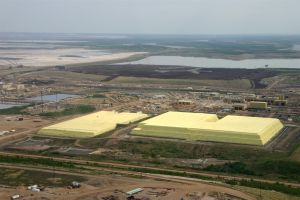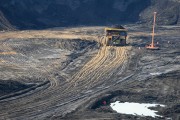Ever tried buying a car without an inspection? Or having only the engine examined but not the brakes? If so, you'd be playing a game of chance if the car had some rather expensive upcoming maintenance bills. Turns out for investors wanting to put their cash on the oilsands, it's currently not possible to have the full picture on oilsands liabilities.
Canada's oilsands contain the world's largest remaining deposit of oil that is still open to investment by publicly-traded oil companies. That is precisely why there has been 112 billion dollars invested into the oilsands over the last decade. Clearly, the oilsands are seen as crucial to the long-term financial future of not only many of the world's leading oil companies but also many of the investors backing these oil companies.
Yet despite all this investment, the economics of oilsands extraction, even at today's high prices, are marginal — especially when compared to other oil sources, and a lack of disclosure by companies may be making the financial picture look better than it actually is.
 Major costs — including the multi-billion dollar price tag for reclaiming the land disturbed by oilsands mining — are largely carried off the balance sheet, making investment in the oilsands seem more profitable on paper than it is in reality. For instance, if a fair value of reclamation cannot be determined, then it need not be included in a company's annual financial filings. Consequently some of the largest stockpiles of sulphur and coke in the world - by products of oilsands upgrading — do not enter into the financial accounting of some oilsands companies. This uncertainty on reclamation liabilities is not unique to the oilsands — it is similar for other unconventional resources like deep-water, offshore oil as well as shale gas and oil.
Major costs — including the multi-billion dollar price tag for reclaiming the land disturbed by oilsands mining — are largely carried off the balance sheet, making investment in the oilsands seem more profitable on paper than it is in reality. For instance, if a fair value of reclamation cannot be determined, then it need not be included in a company's annual financial filings. Consequently some of the largest stockpiles of sulphur and coke in the world - by products of oilsands upgrading — do not enter into the financial accounting of some oilsands companies. This uncertainty on reclamation liabilities is not unique to the oilsands — it is similar for other unconventional resources like deep-water, offshore oil as well as shale gas and oil.
To better understand and manage the risks associated with oilsands development, today the Pembina Institute, in collaboration with Ceres, is releasing Full Disclosure, a briefing note about how investors can engage with both companies and securities regulators to encourage improved disclosure of environmental liabilities from development of the oilsands.
This briefing note builds on Pembina's research contained in our first report on the reclamation liabilities associated with oilsands mining, Toxic Liability. While Toxic Liability focused more on the impacts for Albertans, there's also been growing scrutiny from the international investment community on oilsands operations.
There are increasing numbers of shareholder resolutions on the oilsands being tabled at energy company's annual general meetings. Some financial institutions such as the Royal Bank of Canada are increasing their scrutiny of the opposition (and resultant financial liabilities) from aboriginal groups affected by oilsands projects the bank is underwriting.
Since Toxic Liability was released last fall, I've been requested to speak at a number of investor forums including the Sustainable Investment Research Analyst Network and the UN Principles for Responsible Investment. In May I was invited to present to several investment firms and financial services companies in New York and Boston, who were curious to hear Pembina's analysis on just how many liabilities are actually being disclosed to investors and how they can incent companies and securities regulators to provide investors with a better accounting of their financial health.
Just last week, NEI Investments, on behalf of a group of institutional investors with over $1.2 trillion in assets under management, wrote a letter to the Alberta Environmental Monitoring Panel. It reads,
"Controversy and conflicting information about the extent of oil sands environmental impacts creates unwelcome uncertainty for investors. If the impacts are not understood, acknowledged and mitigated in a timely fashion, over the long term companies may be exposed to risks."
As the reclamation liabilities continue to accrue in north-eastern Alberta from oilsands development, the scrutiny paid by risk-averse investors will likely only increase. They want to know what exactly they are getting into and how it will affect their competitiveness and long-term profitability. Our newly released Full Disclosure offers recommendations to investors on how to engage security regulators to improve disclosure rules and how to minimize their exposure to oilsands liabilities.
All investors should have the ability to have an 'inspection' of their oilsands investments before making the decision to buy. Giving them access to the data on reclamation liabilities empowers investors to make informed investment decisions and avoid the lemons.









